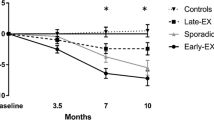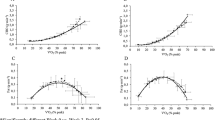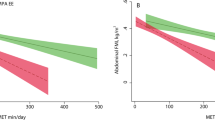Abstract
Background/Objectives:
Although the impact of passive video games (PVGs) on energy intake has been previously explored in lean adolescents, data are missing on the nutritional adaptations to passive and active video games (AVGs) in obese adolescents. It is also unknown whether isoenergetic AVGs and exercise (EX) differently affect food consumption in youth.
Subjects/Methods:
Nineteen obese adolescent boys (12–15 years old) had to complete four 1-hour sessions in a crossover manner: control (CON; sitting on a chair), PVG (boxing game on Xbox 360), AVG (boxing game on Xbox Kinect 360) and EX (cycling). The EX was calibrated to generate the same energy expenditure as the AVG session. Energy expenditure was measured using a K4b2 portable indirect calorimeter. Ad libitum food intake (buffet-style meal) and appetite sensations (visual analogue scales) were assessed after the sessions.
Results:
As expected, mean energy expenditure was similar between AVG (370±4 kcal) and EX (358±3 kcal), both of which were significantly higher than PVG (125±7 kcal) and CON (98±5 kcal) (P<0.001). However, ad libitum food intake after the sessions was not significantly different between CON (1174±282 kcal), PVG (1124±281 kcal), AVG (1098±265 kcal) and EX (1091±290 kcal). Likewise, the energy derived from fat, carbohydrate and protein was not significantly different between sessions, and appetite sensations were not affected.
Conclusions:
Energy intake and food preferences after an hour of AVG or PVG playing remain unchanged, and isoenergetic sessions of AVG and EX at moderate intensity induce similar nutritional responses in obese adolescent boys.
This is a preview of subscription content, access via your institution
Access options
Subscribe to this journal
Receive 12 print issues and online access
$259.00 per year
only $21.58 per issue
Buy this article
- Purchase on Springer Link
- Instant access to full article PDF
Prices may be subject to local taxes which are calculated during checkout
Similar content being viewed by others
References
Dunstan DW, Barr EL, Healy GN, Salmon J, Shaw JE, Balkau B et al. Television viewing time and mortality: the Australian Diabetes, Obesity and Lifestyle Study (AusDiab). Circulation 2010; 121: 384–391.
Ekelund U, Brage S, Froberg K, Harro M, Anderssen SA, Sardinha LB et al. TV viewing and physical activity are independently associated with metabolic risk in children: the European Youth Heart Study. PLoS Med 2006; 3: e488.
Rideout VJ, Foehr UG, Roberts DF . Generation M2 Media in the Lives of 8-to-18-Year-Olds. The Henry J Kaiser Family Foundation: California, CA, USA, 2010 Contract No.: Document Number.
Williams JG, Doyle S, Harris E . Growing up in Ireland National Longitudinal Study of Children, The Lives of 9-Year-Olds. The Stationary Office: Dublin, 2009 Contract No.: Document Number.
Viner RM, Cole TJ . Television viewing in early childhood predicts adult body mass index. J Pediatr 2005; 147: 429–435.
Mark AE, Boyce WF, Janssen I . Television viewing, computer use and total screen time in Canadian youth. Paediatr Child Health 2006; 11: 595–599.
Janz KF, Mahoney LT . Maturation, gender, and video game playing are related to physical activity intensity in adolescents: the Muscation Study. Pediatr Exerc Sci 1997; 9: 353–363.
Chaput JP, Drapeau V, Poirier P, Teasdale N, Tremblay A . Glycemic instability and spontaneous energy intake: association with knowledge-based work. Psychosom Med 2008; 70: 797–804.
Chaput JP, Tremblay A . Acute effects of knowledge-based work on feeding behavior and energy intake. Physiol Behav 2007; 90: 66–72.
Chaput JP, Visby T, Nyby S, Klingenberg L, Gregersen NT, Tremblay A et al. Video game playing increases food intake in adolescents: a randomized crossover study. Am J Clin Nutr 2011; 93: 1196–1203.
Mathieu ME, Kakinami L . Active video games could be the solution to the increased energy intake reported with sedentary video games. Am J Clin Nutr 2011; 94: 1150–1151.
O'Donovan C, Roche EF, Hussey J . The energy cost of playing active video games in children with obesity and children of a healthy weight. Pediatr Obes 2013; 9: 310–317.
Graves L, Stratton G, Ridgers ND, Cable NT . Energy expenditure in adolescents playing new generation computer games. Br J Sports Med 2008; 42: 592–594.
Maddison R, Foley L, Ni Mhurchu C, Jiang Y, Jull A, Prapavessis H et al. Effects of active video games on body composition: a randomized controlled trial. Am J Clin Nutr 2011; 94: 156–163.
Chaput JP, Sjodin AM . Active video games could be the solution to the increased energy intake reported with sedentary video games: Reply to M-E Mathieu and L Kakinami. Am J Clin Nutr 2011; 94: 1150–1156.
Nemet D, Arieli R, Meckel Y, Eliakim A . Immediate post-exercise energy intake and macronutrient preferences in normal weight and overweight pre-pubertal children. Int J Pediatr Obes 2010; 5: 221–229.
Bozinovski NC, Bellissimo N, Thomas SG, Pencharz PB, Goode RC, Anderson GH . The effect of duration of exercise at the ventilation threshold on subjective appetite and short-term food intake in 9 to 14 year old boys and girls. Int J Behav Nutr Phys Act 2009; 6: 66.
Thivel D, Isacco L, Montaurier C, Boirie Y, Duche P, Morio B . The 24-h energy intake of obese adolescents is spontaneously reduced after intensive exercise: a randomized controlled trial in calorimetric chambers. PLoS One 2012; 7: e29840.
Thivel D, Isacco L, Rousset S, Boirie Y, Morio B, Duché P . Intensive exercise: A remedy for childhood obesity? Physiol Behav 2011; 102: 132–136.
Cole TJ, Bellizzi MC, Flegal KM, Dietz WH . Establishing a standard definition for child overweight and obesity worldwide: international survey. BMJ 2000; 320: 1240–1243.
Thivel D, Metz L, Julien A, Morio B, Duche P . Obese but not lean adolescents spontaneously decrease energy intake after intensive exercise. Physiol Behav 2014; 123: 41–46.
Lazzer S, Agosti F, De Col A, Sartorio A . Development and cross-validation of prediction equations for estimating resting energy expenditure in severely obese Caucasian children and adolescents. Br J Nutr 2006; 96: 973–979.
Peyrot N, Thivel D, Isacco L, Morin JB, Duche P, Belli A . Do mechanical gait parameters explain the higher metabolic cost of walking in obese adolescents? J Appl Physiol (1985) 2009; 106: 1763–1770.
Smallwood SR, Morris MM, Fallows SJ, Buckley JP . Physiologic responses and energy expenditure of kinect active video game play in schoolchildren. Arch Pediatr Adolesc Med 2012; 166: 1005–1009.
Flint A, Raben A, Blundell JE, Astrup A . Reproducibility, power and validity of visual analogue scales in assessment of appetite sensations in single test meal studies. Int J Obes Relat Metab Disord 2000; 24: 38–48.
Thivel D, Isacco L, Taillardat M, Rousset S, Boirie Y, Morio B et al. Gender effect on exercise-induced energy intake modification among obese adolescents. Appetite 2011; 56: 658–661.
Williams JG, Eston R, Furlog B . CERT: a perceived exertion scale of young children. Percept Mot Skills 1994; 79: 1451–1458.
Branton A, Akhavan T, Gladanac B, Pollard D, Welch J, Rossiter M et al. Pre-meal video game playing and glucose reduce food intake in normal weight boys. Appetite 2014; 83: 256–262.
Moag-Stahlberg A, Miles A, Marcello M . What kids say they do and what parents think kids are doing: the ADAF/Knowledge Networks 2003 Family Nutrition and Physical Activity Study. J Am Diet Assoc 2003; 103: 1541–1546.
Lyons EJ, Tate DF, Ward DS, Wang X . Energy intake and expenditure during sedentary screen time and motion-controlled video gaming. Am J Clin Nutr 2012; 96: 234–239.
Hill JO, Wyatt HR, Reed GW, Peters JC . Obesity and the environment: where do we go from here? Science 2003; 299: 853–855.
Saunders TJ, Chaput JP, Goldfield GS, Colley RC, Kenny GP, Doucet E et al. Children and youth do not compensate for an imposed bout of prolonged sitting by reducing subsequent food intake or increasing physical activity levels: a randomised cross-over study. Br J Nutr 2013; 111: 747–754.
Dodd CJ, Welsman JR, Armstrong N . Energy intake and appetite following exercise in lean and overweight girls. Appetite 2008; 51: 482–488.
Thivel D, Chaput JP . Are post-exercise appetite sensations and energy intake coupled in children and adolescents? Sports Med 2014; 44: 735–741.
Rowland TW . The biological basis of physical activity. Med Sci Sports Exerc 1998; 30: 392–399.
Thivel D, Aucouturier J, Metz L, Morio B, Duche P . Is there spontaneous energy expenditure compensation in response to intensive exercise in obese youth? Pediatr Obes 2013; 9: 147–154.
Ridgers ND, Timperio A, Cerin E, Salmon J . Compensation of physical activity and sedentary time in primary school children. Med Sci Sports Exerc 2014; 46: 1564–1569.
Rutters F, Nieuwenhuizen AG, Lemmens SG, Born JM, Westerterp-Plantenga MS . Acute stress-related changes in eating in the absence of hunger. Obesity (Silver Spring) 2009; 17: 72–77.
Acknowledgements
This study was supported by the 2012 DANONE Institute Research Award. The 2012 Danone Institute Research Grant funded this work.
Author information
Authors and Affiliations
Corresponding author
Ethics declarations
Competing interests
The authors declare no conflict of interest.
Rights and permissions
About this article
Cite this article
Chaput, J., Schwartz, C., Boirie, Y. et al. Energy intake adaptations to acute isoenergetic active video games and exercise are similar in obese adolescents. Eur J Clin Nutr 69, 1267–1271 (2015). https://doi.org/10.1038/ejcn.2015.31
Received:
Revised:
Accepted:
Published:
Issue Date:
DOI: https://doi.org/10.1038/ejcn.2015.31
This article is cited by
-
Acute post-exercise energy and macronutrient intake in lean and obese youth: a systematic review and meta-analysis
International Journal of Obesity (2016)
-
Reduced neural response to food cues following exercise is accompanied by decreased energy intake in obese adolescents
International Journal of Obesity (2016)



